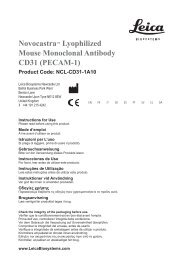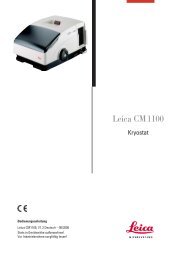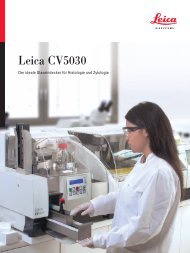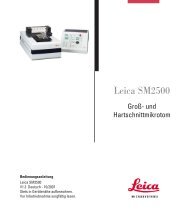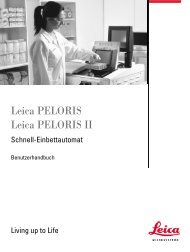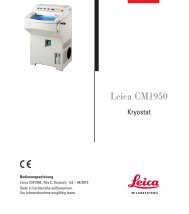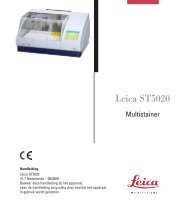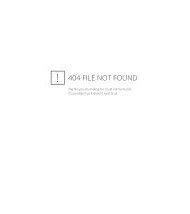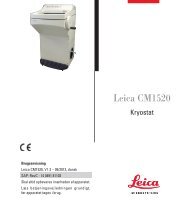Info - Leica Biosystems
Info - Leica Biosystems
Info - Leica Biosystems
Create successful ePaper yourself
Turn your PDF publications into a flip-book with our unique Google optimized e-Paper software.
Novocastra Liquid Mouse Monoclonal Antibody<br />
Melanoma Marker (HMB45)<br />
Product Code: NCL-L-HMB45<br />
Intended Use<br />
For in vitro diagnostic use.<br />
NCL-L-HMB45 is intended for the qualitative identification by light microscopy of human HMB45 antigen in paraffin sections. The clinical<br />
interpretation of any staining or its absence should be complemented by morphological studies using proper controls and should be<br />
evaluated within the context of the patient’s clinical history and other diagnostic tests by a qualified pathologist.<br />
Principle of Procedure<br />
Immunohistochemical (IHC) staining techniques allow for the visualization of antigens via the sequential application of a specific antibody<br />
to the antigen (primary antibody), a secondary antibody to the primary antibody and an enzyme complex with a chromogenic substrate<br />
with interposed washing steps. The enzymatic activation of the chromogen results in a visible reaction product at the antigen site. The<br />
specimen may then be counterstained and coverslipped. Results are interpreted using a light microscope and aid in the differential<br />
diagnosis of pathophysiological processes, which may or may not be associated with a particular antigen.<br />
Clone<br />
HMB45<br />
Immunogen<br />
Extract of pigmented melanoma metastases from lymph nodes.<br />
Specificity<br />
Human HMB45 antigen.<br />
Reagent Composition<br />
NCL-L-HMB45 is a liquid tissue culture supernatant containing sodium azide as a preservative.<br />
Ig Class<br />
IgG1, kappa<br />
Total Protein<br />
Total Protein Concentration<br />
Refer to vial label for lot specific total protein concentration.<br />
Antibody Concentration<br />
Greater than or equal to 10.8 mg/L as determined by ELISA. Refer to vial label for lot specific Ig concentration.<br />
Recommendations On Use<br />
Immunohistochemistry on paraffin sections.<br />
Enzyme Induced Epitope Retrieval (EIER): Please follow the instructions for use in Novocastra Enzyme Proteinase K (IHC).<br />
Suggested dilution: 1:60 for 30 minutes at 25 °C. This is provided as a guide and users should determine their own optimal working<br />
dilutions.<br />
Visualization: Please follow the instructions for use in the Novolink Polymer Detection Systems. For further product information or<br />
support, contact your local distributor or regional office of <strong>Leica</strong> <strong>Biosystems</strong>, or alternatively, visit the <strong>Leica</strong> <strong>Biosystems</strong> Web site,<br />
www.<strong>Leica</strong><strong>Biosystems</strong>.com<br />
The performance of this antibody should be validated when utilized with other manual staining systems or automated platforms.<br />
Storage and Stability<br />
Store at 2–8 °C. Do not freeze. Return to 2–8 °C immediately after use. Do not use after expiration date indicated on the vial label.<br />
Storage conditions other than those specified above must be verified by the user.<br />
Specimen Preparation<br />
The recommended fixative is 10% neutral-buffered formalin for paraffin-embedded tissue sections.<br />
Warnings and Precautions<br />
This reagent has been prepared from the supernatant of cell culture. As it is a biological product, reasonable care should be taken when<br />
handling it.<br />
This reagent contains sodium azide. A Material Safety Data Sheet is available upon request or available from<br />
www.<strong>Leica</strong><strong>Biosystems</strong>.com<br />
Consult federal, state or local regulations for disposal of any potentially toxic components.<br />
Specimens, before and after fixation, and all materials exposed to them, should be handled as if capable of transmitting infection and<br />
disposed of with proper precautions. 1 Never pipette reagents by mouth and avoid contacting the skin and mucous membranes with<br />
reagents and specimens. If reagents or specimens come in contact with sensitive areas, wash with copious amounts of water. Seek<br />
medical advice.<br />
Minimize microbial contamination of reagents or an increase in non-specific staining may occur.<br />
Incubation times or temperatures, other than those specified, may give erroneous results. Any such changes must be validated by the<br />
user.<br />
HMB45-L-CE<br />
Page 2



